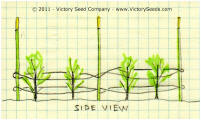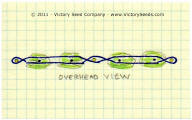Florida Weave Method
of
Trellising Tomato Plants
by Mike Dunton
There are many methods that you can employ for
keeping your tomato plants off of the ground. Along with the method
described on this page, we also
use tomato baskets here on the farm. You can review the basket information by
clicking here.
How you support our tomato crop is not
important. The main factor is that you keep them
erect. By doing so, their contact with the soil is minimized and air
is allowed to circulate around them. This helps reduce disease and
promote even ripening.
The Florida Weave method is very simple and
the only supplies required are some form of posts and string. We personally use
steel fence "t-posts" and sisal binder twine. The only reason that we
chose these two materials is that we started out with a lot of t-posts that
were left over as a result of
ripping out pasture fences. The binder twine is cheaply available from
our
local farm supply store.
The installation process is easy. After
laying out the rows in your garden and planting your plants, a t-post is
pounded into the ground at the end of each row. T-posts are also
placed every two plants. As in the picture to the right, if you have an
odd number of plants, you can stretch to three plants between posts.
Starting in line with the base of the plants,
tie off the spool of twine to the first end post. Pull the twine down
the row, weaving behind the plants, then in front of the second post, then
behind the next section of plants, then in front of the next post, etc.


The sketches are a bit crude, but hopefully they will help you better
understand my instructions. |
When you reach the end of the row, pull the
twine tight, loop around the post a couple of times, and return at the same
level, this time reversing the path you initially took. When you reach your
original starting point, pull taught, tie off the line, and cut. If
the plants are tall enough, go ahead and make another run, a little higher
up on the plants.
 You
will continue this process throughout the growing season as needed. Yes it takes a little bit of time, but the results are worth it. The
photograph on the right shows plants fairly early in the season. Notice that we mulch with straw or grass clippings. This also
helps to reduce disease infections from soil-borne pathogens and
acts as mulch to help retain soil moisture. You
will continue this process throughout the growing season as needed. Yes it takes a little bit of time, but the results are worth it. The
photograph on the right shows plants fairly early in the season. Notice that we mulch with straw or grass clippings. This also
helps to reduce disease infections from soil-borne pathogens and
acts as mulch to help retain soil moisture.
I hope that you found this page useful.
It is intended as an informational resource and advice based on our
experience. It should be used as a guideline and tailored to your own
personal gardening adventure.
|